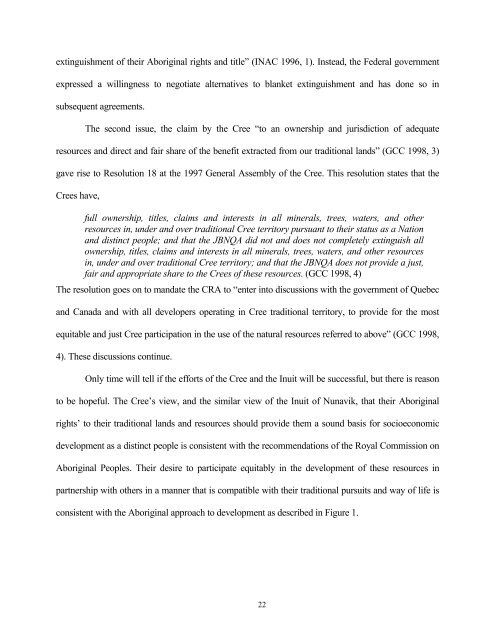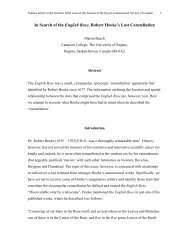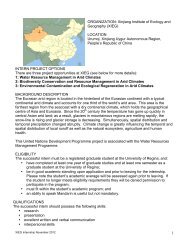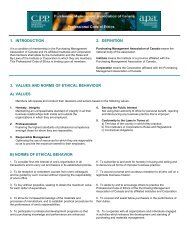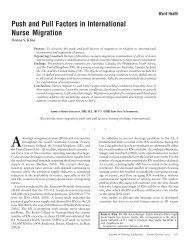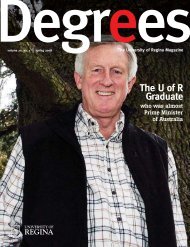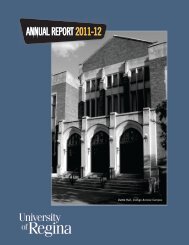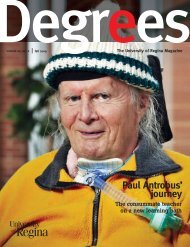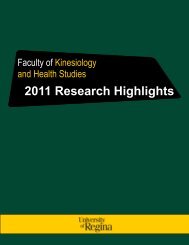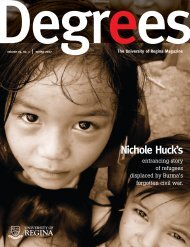The Indigenous Land Claims in New Zealand and Canada
The Indigenous Land Claims in New Zealand and Canada
The Indigenous Land Claims in New Zealand and Canada
You also want an ePaper? Increase the reach of your titles
YUMPU automatically turns print PDFs into web optimized ePapers that Google loves.
ext<strong>in</strong>guishment of their Aborig<strong>in</strong>al rights <strong>and</strong> title” (INAC 1996, 1). Instead, the Federal governmentexpressed a will<strong>in</strong>gness to negotiate alternatives to blanket ext<strong>in</strong>guishment <strong>and</strong> has done so <strong>in</strong>subsequent agreements.<strong>The</strong> second issue, the claim by the Cree “to an ownership <strong>and</strong> jurisdiction of adequateresources <strong>and</strong> direct <strong>and</strong> fair share of the benefit extracted from our traditional l<strong>and</strong>s” (GCC 1998, 3)gave rise to Resolution 18 at the 1997 General Assembly of the Cree. This resolution states that theCrees have,full ownership, titles, claims <strong>and</strong> <strong>in</strong>terests <strong>in</strong> all m<strong>in</strong>erals, trees, waters, <strong>and</strong> otherresources <strong>in</strong>, under <strong>and</strong> over traditional Cree territory pursuant to their status as a Nation<strong>and</strong> dist<strong>in</strong>ct people; <strong>and</strong> that the JBNQA did not <strong>and</strong> does not completely ext<strong>in</strong>guish allownership, titles, claims <strong>and</strong> <strong>in</strong>terests <strong>in</strong> all m<strong>in</strong>erals, trees, waters, <strong>and</strong> other resources<strong>in</strong>, under <strong>and</strong> over traditional Cree territory; <strong>and</strong> that the JBNQA does not provide a just,fair <strong>and</strong> appropriate share to the Crees of these resources. (GCC 1998, 4)<strong>The</strong> resolution goes on to m<strong>and</strong>ate the CRA to “enter <strong>in</strong>to discussions with the government of Quebec<strong>and</strong> <strong>Canada</strong> <strong>and</strong> with all developers operat<strong>in</strong>g <strong>in</strong> Cree traditional territory, to provide for the mostequitable <strong>and</strong> just Cree participation <strong>in</strong> the use of the natural resources referred to above” (GCC 1998,4). <strong>The</strong>se discussions cont<strong>in</strong>ue.Only time will tell if the efforts of the Cree <strong>and</strong> the Inuit will be successful, but there is reasonto be hopeful. <strong>The</strong> Cree’s view, <strong>and</strong> the similar view of the Inuit of Nunavik, that their Aborig<strong>in</strong>alrights’ to their traditional l<strong>and</strong>s <strong>and</strong> resources should provide them a sound basis for socioeconomicdevelopment as a dist<strong>in</strong>ct people is consistent with the recommendations of the Royal Commission onAborig<strong>in</strong>al Peoples. <strong>The</strong>ir desire to participate equitably <strong>in</strong> the development of these resources <strong>in</strong>partnership with others <strong>in</strong> a manner that is compatible with their traditional pursuits <strong>and</strong> way of life isconsistent with the Aborig<strong>in</strong>al approach to development as described <strong>in</strong> Figure 1.22


